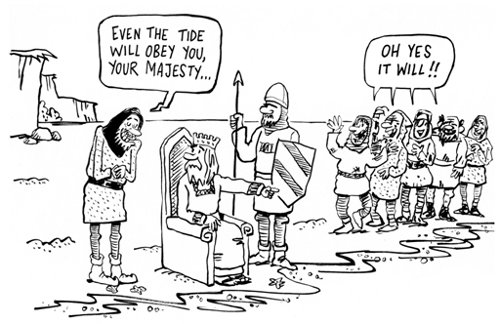
The sight of officials in protective clothing suggests danger and kills confidence
But residents of the contaminated regions of Fukushima have other worries. The sight of officials with meters and protective gear probing a children's playground would be enough to frighten the most hardened parent. Except within the plant itself this gear cannot be necessary. It may be an exercise in authority and "I am an official doing something important" but it certainly damages public confidence.
Advertisement
So how should we view the safety of radiation? With respect, experience and our own judgement, I suggest, the same as we do with UV in sunshine or fast traffic on the highway. It is certainly a mistake to believe that every authority and expert has the answer. The ancient story of King Canute illustrated that – his people thought that he could stop the tide coming in! Such ideas should be discouraged in a democracy.

Inthe story of King Canute the tide ignores the King's command to
retreat, for science and the laws of nature are deaf to the authority of governments, the United Nations, courts of law, majority votes
and the influence of money

Statistics, graphics and public persuasion
as used by Florence Nightingale
A justifiable safety limit
To start to build trust we should follow the example of Florence Nightingale. She collected data on how soldiers were dying in the Crimean War and then drew diagrams -- one is shown above -- to explain the need for better care of sick soldiers. She brought this evidence to the attention of the generals and politicians of the day. She succeeded in spite of the fact that those politicians would never have heard the word data before -- they were still learning about risk from the recent fate of the Charge of the Light Brigade!
Advertisement
Our objective is not dissimilar. We need to expose blind adherence to narrow judgements formed in another age – in our case the Cold War rather than the Napoleonic War. Faced with our task, how might Florence Nightingale have drawn a diagram to illustrate that current radiation regulations are inept and out of touch with modern medicine and biology? Perhaps with the simple diagram below which depicts doses received in a month as proportionate areas.

A set of simple areas comparing monthly doses (the ALARA limit is the small dot at the head of the arrow)
The rather small difference between the monthly dose to the tumour and to healthy tissue (factor 2) contrasts with the difference to the ALARA limit (factor 200,000). A conservative safety limit of 100 mSv per month is suggested. There is no established risk to health from such a dose rate, seen As High As Relatively Safe (AHARS). It is a conservative factor 200 less than the healthy tissue value frequently experienced by the patients in RT treatment and a 1000-fold relaxation of ALARA limit. It would reset safety levels to where they were in 1934 and suggest that up to ten full CT scans should be acceptable per month without concern. Such a new safety limit might be argued up or down by a factor two or three but a value different by a factor of more than ten would be unreasonable.
This is the second in a two part series on the risks and benefits of nuclear power. You can read the first here.
The author is a member of the SARI group, Scientists for Accurate Radiation Information http://radiationeffects.org/ This article is based on an invited lecture given at the Second AGORA Conference, Tokyo. and at the British Chamber of Commerce in Japan, 8 and 9 Dec. 2013. A more extended discussion with references may be found in the book Radiation and Reason available from http://www.radiationandreason.com together with other recent articles in Kindle, ePub, Japanese and Chinese editions, also available from Amazon.
Discuss in our Forums
See what other readers are saying about this article!
Click here to read & post comments.
35 posts so far.